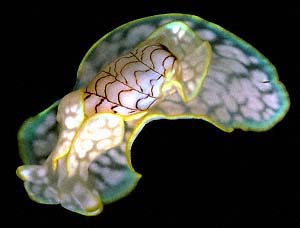
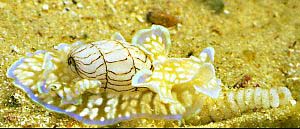
Micromelo undata
(Bruguiere, 1792)?
Order: CEPHALASPIDEA
Superfamily: ACTEONOIDEA
Family: Hydatinidae
PHOTO
UPPER: Long Reef, Sydney, New South Wales. November 1989. Photo: Bill Rudman.
LOWER: Blue colour form laying egg mass. Margaret River, Western Australia, January 1985. Photo: Clay Bryce.
RELATED TOPIC
Micromelo guamensis (Quoy & Gaimard, 1825)?
There is some debate whether these two species are the same. Micromelo guamensis has been considered an Indo-West Pacific species while Micromelo undata has been a Caribbean species. Read the comments below to see the state of the argument.
Micromelo is closely related to Hydatina physis. In these cephalaspids the animal is beginning to assert itself over the shell which is becoming much thinner and less important as a protective organ.
Reference:
• Rudman, W.B., 1972. Studies on the primitive opisthobranch genera Bullina Ferussac and Micromelo Pilsbry. Zoological Journal of the Linnean Society, 51: 105-119.
Rudman, W.B., 1998 (March 12) Micromelo undata (Bruguiere, 1792)?. [In] Sea Slug Forum. Australian Museum, Sydney. Available from http://www.seaslugforum.net/find/micund
Related messages
Micromelo undata from the Andaman Islands
February 17, 2010
From: C.R. Sreeraj
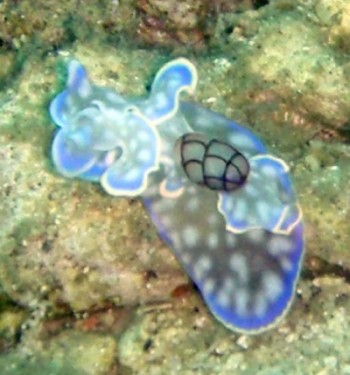
Sir,
Here is another record from the Andaman Islands (Micromelo guamensis ?).
Locality: Ritchies archipelago, Andaman Islands, Andaman Sea, Indian Ocean, 25 January 2009. Photographer: Vikas, Dive India, Havelock.
Regards
CR
crsreeraj@gmail.com
Sreeraj, C.R., 2010 (Feb 17) Micromelo undata from the Andaman Islands. [Message in] Sea Slug Forum. Australian Museum, Sydney. Available from http://www.seaslugforum.net/find/22968Dear CR,
From the relative size of the shell I would say that this is a juvenile animal. Concerning the name C. guamensis: we previously considered there were two species, C. guamensis in the Indo-West Pacific and C. undata in the tropical Atlantic, but we know consider they are the same so we use the name C. undata because it is the oldest.
Best wishes,
Bill Rudman
Micromelo undata found sthn Queensland
January 19, 2009
From: Gary Cobb

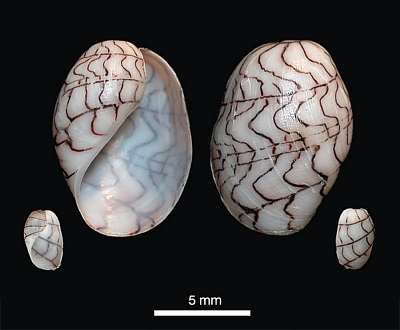
Hi Bill and Everyone!
For the Forum's record I present Micromelo undata from our backyard. This species has been found subtidally and intertidally. The shell is very delicate and light in weight. I guess when the animal is frightened it uses some source of "origami" to draw itself into the shell!
Locality: Sunshine Coast, sthn Queensland, 20 m - intertidal, Queensland, Australia, Pacific Ocean, 10 June 2008, Subtidal and Intertidal. Length: max 25 mm. Photographer: Gary Cobb.
Cheers,
Gary
gary@nudibranch.com.au
Cobb, G.C., 2009 (Jan 19) Micromelo undata found sthn Queensland. [Message in] Sea Slug Forum. Australian Museum, Sydney. Available from http://www.seaslugforum.net/find/22144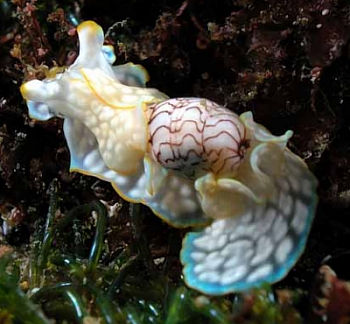
Thanks Gary,
Were the two shells photographed together at the same magnification or is this a composite photo? Certainly the shape of the small ones appears more juvenile.
Your comment about needing some form of origami to fit into its shell raises some interesting points. Looking at my field notes I have seen small animals completely retracted into the shell but not adults. Have you seen big ones completely retracted? If they do, it certainly raises the question of where does the animal volume go? Studies on some bivalves and marine snails suggest that they can enlarge their size by drawing seawater into sacs in their foot - presumably they can force this water out when they wish to make themelves smaller. Much of the volume of an opisthbranch consists of water, but I am not sure whether it can be released quickly if the animal wishes to retreat to he safety of its shell. Net folding - as in origami - is a nice idea but in a slug it would be more like folding a balloon than a piece of paper. Anyone with any thoughts - or information - on the topic?
Best wishes,
Bill Rudman
Re: Micromelo undata - developing veligers
November 20, 2006
From: Philibert Bidgrain

Concerning message #18368:
Dear Bill,
Reunion Island sea slugs.
I haven't observed the egg mass on the day of hatching but only after two days and 6 days. I send you in this message the microscopic photo taken after two days...
There is actually too much swell, but as soon as possible I go back to the "Micromelo undata spot" and I try to found and take a photo of the egg mass on the day of hatching.
Philibert Bidgrain
http://vieoceane.free.fr/runseaslug/indexslug.htm
pbidgrain@yahoo.fr
Bidgrain, P., 2006 (Nov 20) Re: Micromelo undata - developing veligers. [Message in] Sea Slug Forum. Australian Museum, Sydney. Available from http://www.seaslugforum.net/find/18375Dear Philibert,
Thanks for the photo. It certainly looks like a multicelled embryo rather than an uncleaved single-celled egg but I can't be 100% sure. If it is an embryo then perhaps it is like related species I have observed in which eggs are 'brooded' for some time before being laid.
Best wishes,
Bill Rudman
Micromelo undata - developing veligers
November 16, 2006
From: Philibert Bidgrain

Dear Bill,
To accompany my earlier message #18354, here are some microscopic photos of the developing larvae of Micromelo undata in the egg ribbon. You will see that in this species there is only one larva in each capsule. [The photo was taken 6 days after spawning].
Philibert Bidgrain
pbidgrain@yahoo.fr
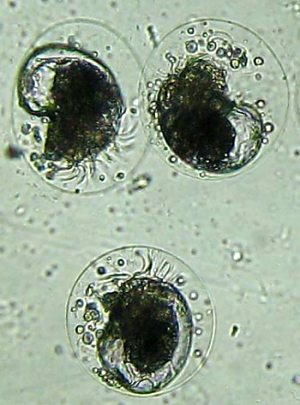
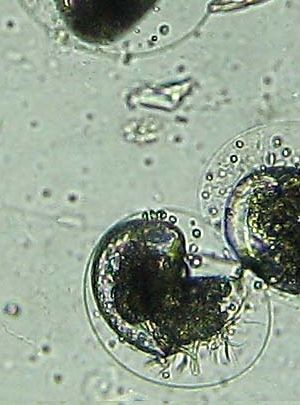
Dear Philibert,
The veliger larvae are quite well developed for only 6 days. Did you by chance have a look at the egg mass on the day of hatching? It would be interesting to know if the 'larvae' were just a single-celled egg or a few celled embryo at that time. I have observed that some acteonids and their relatives can brood their egg in the mantle cavity or in the reproductive ducts and only actually 'lay' the egg ribbon when the larvae are almost at the veliger stage. It would be interesting to know of Micromelo did that as well.
You can see these veligers have well-developed shells and very large velar lobes. The large hair-like structures you can see are the large cilia which line the edge of the large velar lobes which sit on each side of the mouth and are used in swimming.
Best wishes,
Bill Rudman
Collective spawning in Micromelo undata
November 16, 2006
From: Philibert Bidgrain

Concerning message #17376:
Dear Bill,
Reunion Island sea slugs: I couldn't find in your forum any observation about Micromelo spawning. Last week I found on a rocky coast an unusual concentration of Micromelo undata. I observed on a rock about 30 animals in 1 m2 (more than 100 in this area). In small crevices and gutters there were numerous spawns and about 10 animals burrowing among sediments.
In the photo below you can observe, some small yellowish egg masses.
Spawn structure: A yellowish (in natural light) helicoidal spawn (size : 6 x 4 mm)..
Locality: Etang sale les bains, 80 cm, Reunion Island, Indian Ocean, october 2006, pool on a rocky coast. Photographer: Philibert Bidgrain.
I also have sent some photos of the veliger larvae in a separate message [#18368].
Philibert Bidgrain
http://vieoceane.free.fr/runseaslug/indexslug.htm
pbidgrain@yahoo.fr
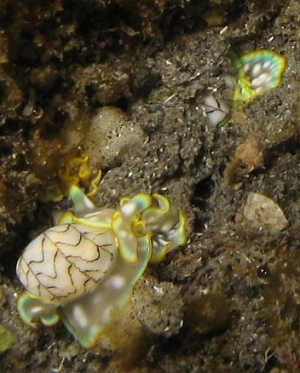

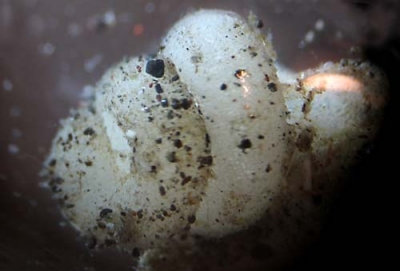
Dear Philibert,
Thanks for this interesting observation. We still have much to learn about aggregations like this. Perhaps the worms they like to eat are abundant in these areas or perhaps they spend more time burrowing than we give them credit for.
Best wishes,
Bill Rudman
Micromelo undata from the Canary Islands
August 19, 2006
From: Christian Kowalewski
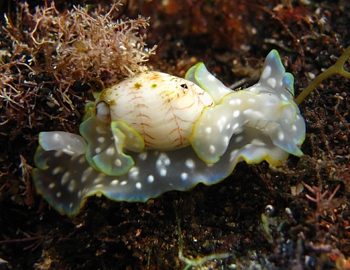
Hallo,
This Micromelo undata was found just below the intertidal, on a rocky substrate with a little mud on the north of the island. There are quite common and night active.
Locality: Tenerife Island, Canary Islands, 1 m, Spain, Atlantic Ocean, 30 May 2006, Just below the intertidal little muddy, rocky. Length: 2.5 cm (on photo) - 5 cm. Photographer: Christian Kowalewski
Thanks
Christian Kowalewski
moratorix@gmx.de
Kowalewski, C.J., 2006 (Aug 19) Micromelo undata from the Canary Islands. [Message in] Sea Slug Forum. Australian Museum, Sydney. Available from http://www.seaslugforum.net/find/17376Thanks Christian,
It surprises me how some species, like M. undata, can get so close to the Mediterranean and yet not quite make it.
Best wishes,
Bill Rudman
Micromelo undata from Bali
April 20, 2006
From: Erwin Kodiat
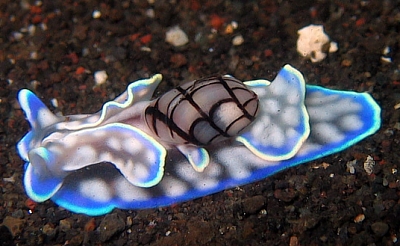
Hi Bill,
found this in Tulamben, Bali. Just need to confirm if it is Micromelo undata.
Locality: Tulamben, 15, Bali, Indonesia, Lombok Strait, 28 January 2006, Sandy bottom. Length: 4 cm. Photographer: Erwin Kodiat.
Thanks
Erwin Kodiat
ungu@terong.com
Kodiat, E., 2006 (Apr 20) Micromelo undata from Bali. [Message in] Sea Slug Forum. Australian Museum, Sydney. Available from http://www.seaslugforum.net/find/16397Dear Erwin,
We used to think there were two species of Micromelo, a green one in the Pacific which was called M. guamensis, and a blue one in the Caribbean which we called M. undata, but there were no anatomical differences and as your photo shows, the blue form is also found in the Pacific, so we consider them all to be a single species, M. undata.
Best wishes,
Bill Rudman
Micromelo undata from South Africa
August 20, 2005
From: Colin Ogden
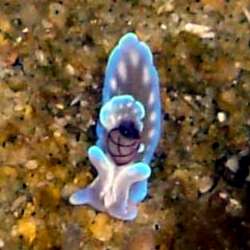
Hi Bill,
Today I found this small creature. At first I thought it was a new nudibranch for me, but on checking on the computer it looks like a Micromelo undata.
Locality: Sodwana Bay, Ribbon Reef, South Africa. Indian ocean coast. Depth: 18 metres. Length: 10 mm. 18 August 2005. Coral reef. Photographer: Colin Ogden
Am I right on this ID.
Thanks for your help,
Regards
Colin
scubaco@iafrica.com
Ogden C M, 2005 (Aug 20) Micromelo undata from South Africa. [Message in] Sea Slug Forum. Australian Museum, Sydney. Available from http://www.seaslugforum.net/find/14599Dear Colin,
Yes this is a juvenile Micromelo undata.
Best wishes,
Bill Rudman
Micromelo undata from northeastern Brazil
February 15, 2005
From: Vinicius Padula
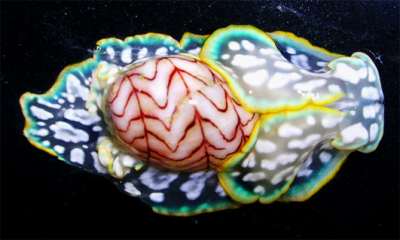
Dear Bill,
Here is one record of Micromelo undata from Recife, in the northeast of Brazil. This beautiful specimen, 30 mm long was in the intertidal zone on a beach.
Locality: Recife, Pernambuco, Brazil. Depth: 1 m. Length: 30 mm. 4 February 2005. Intertidal. Photographer: Vinicius Padula
Best Regards,
Vinicius Padula
viniciuspadula@hotmail.com
Padula, V., 2005 (Feb 15) Micromelo undata from northeastern Brazil. [Message in] Sea Slug Forum. Australian Museum, Sydney. Available from http://www.seaslugforum.net/find/13149Dear Padula,
Despite being two oceans away, I have seen animals with identical colour here in Sydney. Ours usually have browner markings on the shell than yours, but otherwise the colour is remarkably similar
Best wishes,
Bill Rudman
Micromelo undata with own garden
January 31, 2003
From: Valda Fraser
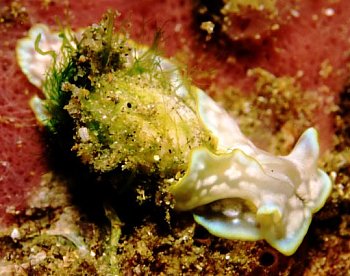
Dear Bill,
I have never seen a Micromelo undata like this before. How did it get to grow such a lush "garden" on its shell?
Locality: Pumula, KwaZulu-Natal, South Africa, tidal pool
Size: 15mm
Date: December 2002
Regards,
Valda Fraser
valdafraser@mweb.co.za
Fraser, V., 2003 (Jan 31) Micromelo undata with own garden. [Message in] Sea Slug Forum. Australian Museum, Sydney. Available from http://www.seaslugforum.net/find/9089Dear Valda,
Time to mow the lawn! I guess not having to mow the lawn is the only benefit of the drought we are having here in eastern Australia - its about 45deg Celsius [105deg F?] in the shade today and my grass/lawn looks like it died some weeks ago - and if it doesn't cool down soon I may go the same way!
Now back to slugs. Filamentous green algae, such as Enteromorpha, are very opportunistic, settling on any clear surface and growing quickly. In this case their spores found the shell of Micromelo. Usually the occasional burrowing in coarse sand seems to keep the shells clean but in this case it looks like your Micromelo is living on a hard rock surface with no sand to burrow in. The only other example I can think of is a photo I have on the Forum of Haminoea cymbalum, with a similar crop on its shell. Interestingly, it was living on a rock platform with no sand to burrow in.
Best wishes,
Bill Rudman
Micromelo undata from New South Wales, Australia
August 14, 2002
From: John Pogonoski

Hi Bill,
Attached is a digital image of a slug that I collected at Angourie Pool on our recent northern New South Wales fish collecting trip. [March 2002]. After a quick look on the Sea Slug Forum I suspect that it is the bubble shell Micromelo undata.
John Pogonoski
johnpog@austmus.gov.au
Pogonoski, J., 2002 (Aug 14) Micromelo undata from New South Wales, Australia. [Message in] Sea Slug Forum. Australian Museum, Sydney. Available from http://www.seaslugforum.net/find/7772Thanks John,
To most of you 'Angourie Pool' will mean nothing. It is however one of those strange man-made places which looks like an ecological slum, but always has a collection of interesting opisthobranchs. It is in northern New South Wales, eastern Australia, just south of the mouth of a large river, the Clarence River, and was cut high into a rock platform many years ago when stone blocks were being quarried for a breakwater at the fishing village of Yamba. The pool is not more than about 30 meters long by 20m wide and at the deepest end about 2m deep. The bottom is scattered with thin flat 'plates' of rock - rubble left over from quarrying. The high tide only reaches the pool once or twice a month. In this apparently inhospitable environment, I can usually find at least 20 species of mainly tropical opisthobranchs on any visit. So if the weather is bad, it is always a place of last resort to visit.
Cheers,
Bill Rudman
Micromelo undata from Christmas Island
May 3, 2002
From: W.B. Rudman

Here is a record of Micromelo undata from John Hicks' Christmas Island, Indian Ocean collections.
PHOTO: AM C130158, 7 mm long alive. June 1981, off District Officer's Point, 10m, under rock, near black sponge, Christmas Is., Indian Ocean. Photo: John Hicks
From its size and shape, this animal is clearly a juvenile.
Best wishes,
Bill Rudman
Micromelo undata from Florida
January 31, 2002
From: Linda Ianniello


Hello,
I see that you don't have any photos of the Atlantic version of Micromelo undata. I have seen it several times off Delray Beach, Florida, in about 15ft [5 meters] of water. The first time was in March, 2001 and then again in the same area this past week [January 2002], always during the day. They are about 1/2 inch long. I hope this helps to "beef up" your display of Florida / Caribbean critters.
Regards,
Linda Ianniello
lindai@us.ibm.com
Ianniello, L., 2002 (Jan 31) Micromelo undata from Florida. [Message in] Sea Slug Forum. Australian Museum, Sydney. Available from http://www.seaslugforum.net/find/6125Thanks Linda,
Your contributions are indeed 'beefing up' the Forum's Caribbean collection. If someone told me your photos had been taken in Sydney I would believe them. Certainly externally there seems to be no difference between the Atlantic M undata and the Indo-West Pacific M. guamensis.
Best wishes,
Bill Rudman
Micromelo undata? - undatus? - more grammar
February 18, 1999
From: Erwin Koehler
Dear Bill,
Micromelo undatus or Micromelo undata?
Erwin
E.Koehler@deutschepost.de
Koehler, E., 1999 (Feb 18) Micromelo undata? - undatus? - more grammar. [Message in] Sea Slug Forum. Australian Museum, Sydney. Available from http://www.seaslugforum.net/find/584Erwin,
See Richard Willan's message (22 May, 1998). He says its M. undata to match the feminine gender of Micromelo.
Cheers,
Bill Rudman.
Re: Recognize this youngster
May 22, 1998
From: Dr Richard Willan
Dear Bill,
I was browsing through past messages on the Sea Slug Forum yesterday when I read the correspondence between you and Bernard Picton on Micromelo.
In 1984 I wrote an article for "Shells and Sea Life" (reference below) on this genus because Steve Long was publishing a colour photo on the front cover of each number and I had taken some nice photos of a living animal from off Cape Byron at that time. As I said then, the beauty of a living Micromelo is a never-to-be-forgotten sight.
Whilst doing the research for that article it became evident that there were no differences in shell shape between Pacific Ocean and Atlantic Ocean popoulations and the differences in colour in the lines on the shell - either red or black - appeared to be merely intraspecific variation (differences between different animals). I said then that the genus Micromelo has only one biological species which is widespread in the tropical Pacific and Atlantic Oceans and although I have seen many living animals of all sizes (none as tiny as 2.5 mm though) over the intervening years nothing has caused me to alter that opinion. Incidently, another member of the same family, Hydatina physis, has this same distribution.
There is one point to make about the formation of the specific name though and it involves the technical point of agreement of the generic and specific names. The name Micromelo is feminine and, because the specific name is an adjective meaning wavy, it must agree with the gender of the genus. So the correct name is Micromelo undata (Bruguiere, 1792).
Reference:
Willan, R.C. 1984. The Guam Bubble Shell Micromelo undatus (Bruguiere, 1792) in Australia. Shells and Sea Life 16(5): 49-50.
Cheers,
Richard
Dr Richard Willan
Museum & Art Gallery of the Northern Territory
Northern Territory
Australia.
richard.willan@nt.gov.au
Willan, R., 1998 (May 22) Re: Recognize this youngster. [Message in] Sea Slug Forum. Australian Museum, Sydney. Available from http://www.seaslugforum.net/find/81I am going to sit on the fence with this one. Since I provided some of the evidence (Rudman, 1972 - See No 14 on publications list) to show that Hydatina physis was a circumglobal species, I guess I should agree that the Micromelo guamensis / Micromelo undata situation is the same. But I still would like some further anatomical comparisons....Bill Rudman
Rudman, W.B., 1998 (May 22). Comment on Re: Recognize this youngster by Dr Richard Willan. [Message in] Sea Slug Forum. Australian Museum, Sydney. Available from http://www.seaslugforum.net/find/81Re: Recognize this youngster
March 26, 1998
From: Bernard Picton
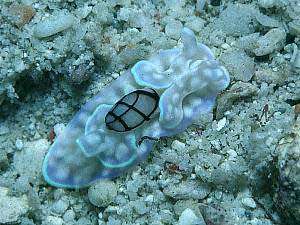
Bill,
I'd be interested in your opinions on Micromelo - again I attach a jpeg - Debelius seems to use the name Micromelo undata for this animal, but I'd agree with you that it's unlikely that the same species is in the Atlantic - I'm not even certain that all the Indo-Pacific ones are a single species? Does anyone have a growth series - this individual seems to have no waves in it's brown longitudinal lines - but it was only about 7mm long.
Bernard Picton
bernard.picton.um@nics.gov.uk
Picton, B., 1998 (Mar 26) Re: Recognize this youngster. [Message in] Sea Slug Forum. Australian Museum, Sydney. Available from http://www.seaslugforum.net/find/80I don't know of any growth series but if we keep on adding photos here we will end up with one ourselves! Marcus & Marcus (1967 - in American Opisthobranch Molluscs, Studies in Tropical Oceanography No 6) describe the anatomy of Caribbean specimens of Micromelo undata. By chance they describe and draw the larval shell (protoconch) and it does seem to have broad colour bands as in Clay's photo, but I am not sure from Marcus & Marcus, whether the colour is black or red in their material. . Bill Rudman
Rudman, W.B., 1998 (Mar 26). Comment on Re: Recognize this youngster by Bernard Picton. [Message in] Sea Slug Forum. Australian Museum, Sydney. Available from http://www.seaslugforum.net/find/80Recognize this youngster
March 12, 1998
From: Clay Carlson
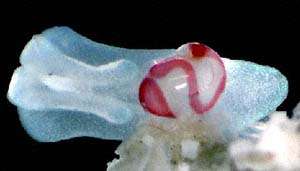
Bill,
Recognize this youngster?
We think we know what it is but put it back rather than try to raise it. The specimen is 2.5mm long. It came from Toguon Bay, Guam, 7m depth. Our guess at this time is that it represents a juvenile Micromelo undata. There is a touch of blue-green showing up on the margin of the tail and I saw a number of adults in the back yard (Bile Bay) a month earlier. [Note: Bile Bay is in the village of Merizo in the southern part of Guam.] Toguon Bay is about 1/2 k north of us. North of that is Umatac Bay--visited 17 March 1819 by the Uranie which just happened to be carrying Quoy & Gaimard. They described Micromelo guamensis from the island. Recently the name has been synonymized with M. undata.
We have no idea what the purpose would be of the red on the juvenile form. While in the Philippines last year a large number of young Atys naucum were found --all with red banded shells that became less noticeable as the size of the animal increased. It would be interesting to know how wide spread the 'juvenile red' phenomena is.
Clay Carlson
Merizo, Guam
clay.carlson@saba.kuentos.guam.ne
Carlson, C. & Hoff, P.J., 1998 (Mar 12) Recognize this youngster. [Message in] Sea Slug Forum. Australian Museum, Sydney. Available from http://www.seaslugforum.net/find/79It reminds me of another bubble-shell, Hydatina amplustre, which has pink bands on its shell, but the shape of the animal certainly looks like Micromelo. If you have a look at the tip of the spire of many marine snails you will see the protoconch or larval shell. This is the shell that protected the larval snail or early juvenile animal. It is often pinkish or red but why this is so I have no idea. You mention that the name of this animal has been replaced by Micromelo undata, which is the name given to a species found in the Caribbean and the Atlantic Coast of South America. Perhaps I am being too conservative, but I would like to see a bit more evidence to support the idea that they are indeed one species.
For those who wonder why we have shelled snails in a Slug Forum, let me explain. Sea Slugs are essentially marine snails which have lost their shells during their evolution. The "Bubble Shells" are a group of primitive opisthobranchs which illustrate various stages in the loss of the shell. The Bubble Shells (Order Cephalaspidea) include many unrelated families. The Hydatinidae have thinly calcified shells and large colourful bodies. They all feed on cirratulinid worms ...Bill Rudman
Rudman, W.B., 1998 (Mar 12). Comment on Recognize this youngster by Clay Carlson. [Message in] Sea Slug Forum. Australian Museum, Sydney. Available from http://www.seaslugforum.net/find/79